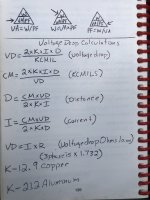FranklinMade
Member
- Location
- Florida
- Occupation
- Electrician Apprentice
Anyone have a VD formula for length?
Like if I had a 50 amp 240v load how far could I run it? Anything would help. Thanks!
2xkxi / cm/vd?
Like if I had a 50 amp 240v load how far could I run it? Anything would help. Thanks!
2xkxi / cm/vd?


